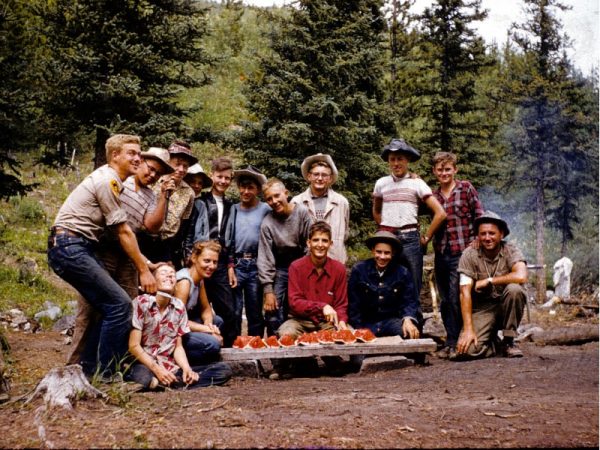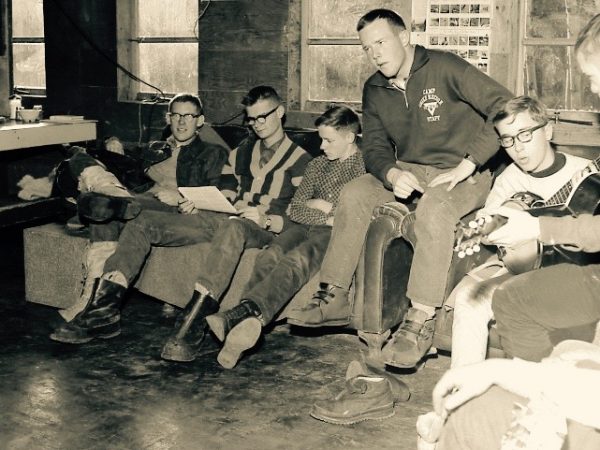The 1950’s saw the camp develop various new programs and consolidate others. War shortages over, and some increased funds allowed the camp to achieve a number of notable improvements. The building of the cabins has already been mentioned. Ray Atkinson left the camp after the 1950 season. George Page filled in 1951 and Murray Faulkner took over in 1952. He remained through the 1956 season.
The Fifties heralded a new prosperity for Canada. Jobs were very plentiful and this had a serious effect on Camp Chief Hector in the early years of the decade. The camp’s policy of paying little for leaders came into serious question. Murray Faulkner was very concerned about the leadership at camp. He had some excellent people such as George Dessen and Reg Houghton, but also had many immature counselors. They were being put into situations beyond their capabilities. As a result, much of the camp program became more centralized as a way of supporting the leaders. Murray campaigned loud and long for increased staff payment and for the policy of arranging before and after camp jobs for leaders.

His influence prevailed and gains were made in this area, although the pay was precious little. Dedication was still the watchword. Improvement came rapidly as a result of this and as a result of increased staff training. Leadership at Hector once more rose to the expected standard in 1953 and on. Murray spoke glowingly of many leaders in camp reports of the time. People like Jim Hawks, Bryce Taylor, Bill Linterman, Denis McClelland, Roy Taylor, Harry Gordon, Dan O’Connor, Don Racher, Bill Forbes-King, Bud Gamble, Beth Hanson, Bill Halliday, Ken Craig, Jim Logan, Milo Freeman, and many others appear on these reports.
Nineteen-fifty three saw a new aluminum roof put on the lodge. In 1954 floors were donated for teepees. By a year or so later, all teepees were so equipped. The ‘Y’s’ Mens Club built a shower house in 1955. Such luxury!
In 1953 Pioneers Camp program was tried out. The campers built their own site at the southwest end of Bowfort Lake and christened it “The Pit”. This kind of senior camping was at camp to stay.

The first Winter Camp was held in 1949 with twelve people attending in -20 degree F temperatures. (It would have been warmer in Celsius.) A second was held in 1950 and featured an overnight hike to Loggers on skis and a sleep out in the snow. Winter camp seemed to lapse for a few years but was reborn again in 1955.
Starting next year, winter camp for older Calgary boys will be an established event at Calgary Y.M.C.A.’s Camp Chief Hector on the Banff Highway. Thirteen boys who proved themselves in the Pioneer Section of Chief Hector’s summer camp were picked before Christmas to attend the camp under Neil “Bud” Gamble, Associate Boys Work Secretary and Bill Forbes-King, the Summer Pioneer Director. After five days of roughing-it in weather that ranged all the way from a mild Chinook to ear-freezing Arctic cold, they returned to Calgary in high spirits. Not one had a cold. Many had gained weight. The most serious complaints were one slightly bruised knee and a mild blisters.

Camp Chief Hector’s winter camp has been proven a success thanks to the teamwork and spirit the boys displayed, and the leadership of Gamble and Forbes-King.
(Calgary Herald, December 1955)
Senior Winter Camp has continued to the present from this start.
Bud Gamble became the camp director in 1957 and was followed by Bill Halliday in 1959. Further expansion of programs, such as the move of Pioneer camping to mountaineering, occurred under the guidance of these men and others such as Laurie Huggard and Harley Smith. A camp staff manual was developed at this time. It has had a few modifications through the years, but the core of it is in use today. Also a wealth of material was generated on canoe techniques, crafts, hiking tips, and many old songs and legends were put to paper.
The legends have been handed down through the years and have graced many a campfire.
The Story of Kananaskis
In the area around the Camp Kananaskis site live the Stoney Indians. They were usually a fairly peaceful tribe who hunted for food right around where our camp is situated. However, one year there was a very sever winter in the mountains and many of the animals that the Indians hunted did not survive until the spring. The result was that the Stonies had to move elsewhere in search of food.
They started to move east in search of food. However, at a place about fifteen miles northeast of Camp Kananaskis they met up with a very savage tribe of Indians. The result was a battle in which many of the braves on both sides were slain. The place of this battle is today known as Deadman’s Hill or in the Indian language it is Chipei Watchi. After the battle both tribes moved on in search of food. After a very successful hunt the Stonies returned home passing again by Deadman’s Hill. While there, they built graves on top of the hill to bury the 39 dead from both sides. But there was something that puzzled them. The body of one of their best young braves, who had been felled by an opponent, was missing. His body was the only one that seemed to be missing. Still wondering about this the hunters returned to their hungry tribe with the food they had obtained. However, much later that summer they were disturbed one night by a lone Indian brave wandering into their camp. It was their missing campanion. Many of the members of the tribe were startled but happy to see him.
They held a joyful dance that night for their returned and newly named brave, Kananaskis. This name was given to him by the medicine man and means “one with courage and strength”. As Kananaskis recovered his health, he told his people how after being struck by an axe he was knocked unconscious and lost his memory. When he regained his consciousness he was alone with the corpses of the dead Indians, none of whom he recognized as his friends. The result was that he took to wandering about on foot living on small animals, birds and plants. Gradually, over the summer, he regained enough of his memory to recognize some of the members of his own tribe. Before this he would only observe them from a hiding place as he saw them as being enemies. Once he was sure that these Indians were friendly he decided to go into their camp and find out. This is when he was welcomed back to the tribe by the other Indians.
Another interesting part of the legend is that below Deadman’s Hill there is a river called Wine-hin-ai-wap-ta or Ghost. It is believed even to this day there is a ghost that wanders back and forth across Deadman’s Hill. It has come to pick up skulls of the dead who are buried at the top of Deadman’s Hill. And the ghost will continue to wander back and forth across the hill until it finds the missing skull. However, it will never find the skull it is looking for because Kananaskis returned to his tribe and died a very old man and was buried in the Stoney burial grounds.
The old Indian telling this story said we can all learn something from Kananaskis. We have been given a life to live. There are times when our enemies or the devil will try and take away our will and desire to live. However, we must fight back with the same courage and strength that Kananaskis showed. With God’s help we must make a good life out of the life we have been given.
Legends such as this, together with Grand Councils have kept the Indian Theme very much alive at Camp Chief Hector.
Of course camp happenings themselves have created their own legends. One such is that the late fifties and early sixties became the “Spork” Years. The Federal Government under John Diefenbaker had somehow obtained box car loads of Spork (canned luncheon meat) which they donated to camps across the country. Hector got its own box car load and for years afterwards, cans of Spark accompanied every hike and camp dining tables. It was rumored that some staff and campers ate so much of it that they looked like giant cans of Spork.
Another source of camp legends comes from staff recreation events. Stories of waterfights of squeegie parties abound. Squeegie parties were cleaning the lodge floor on a Saturday night. It was always questionable how clean the floors got, but a lot of staff received “baths”. Other recreation of the late fifties and sixties was provided by inviting the “Brewster Girls” to camp for a dance. A week later the invitation would be returned and staff would attend a dance at their location. The Brewster Girls were young ladies from Philadelphia who came to the Canadian Rockies each summer under the capable chaperoning of the indomitable Miss Libb. They stayed at the Brewster ranch at Seebe in the early years thus their name. The name didn’t change even though they spent later summers at the Rafter Six. These dances were the stimulus to many romances conducted through the mails. Starry eyes abounded. Little ever came of these except in the case of Greg “Hot Lips” Howard. He was invited to Philadelphia one Christmas and his way was paid by the girls father. Hot Lips remained tight-lipped about the trip.
<< Camping in the Forties – Camping in the Sixties >>
Note: Hot Lips spilled all in 2012. see Brewster Girls…. Every Hector Guy’s Fantasy